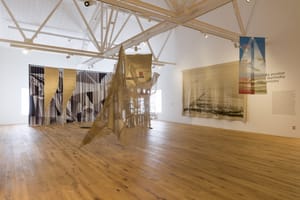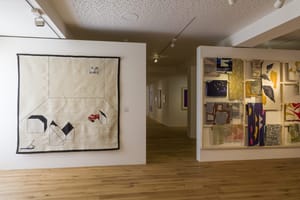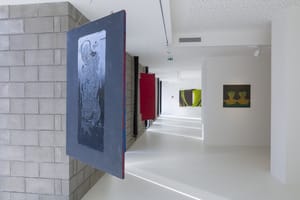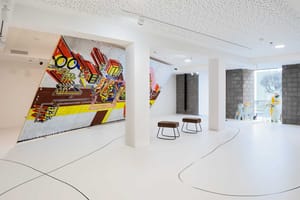- City
- Humpolec
- Street
- Kamarytova 97
- Website
- https://8smicka.com/
- info@8smicka.com
- Tel
- +420 565 650 906
- Founded
- 2018
About venue
Upon private initiative, 8smička Zone for Art was founded in 2018 at the turn-off from the E50 east-west connection and approximately halfway from Prague to Brno on the D1 Motorway. Its most prominent feature is undoubtedly the gallery of modern and contemporary art, which provides passers-by on the main Czech thoroughfare with an excuse for a cultural stop-over. This is another Czech exhibition initiative aimed at blurring the line between the centre and the periphery.
Humpolec is a small town but its location on the main trade route has granted the town an advantageous position since the 16th century, when it became the centre of the tanner’s guild. The industrial history of the town that used to be known as the Czech Manchester is linked to 8smička at first sight – the revitalized textile factory is located in the former Soukenice complex with an area of almost 3000 m². The name of the institution also has historical associations. After 1948, Karel Trnka’s wool fabric factory was together with other textile factories in town incorporated into the state enterprise Sukno. In order to replace the names of the business owners in the plant names the new management resorted to simple serial number markings. Spinning Mill 08 was in operation until 1989 and then it was left abandoned for several years. Since 1995, the complex has been gradually renovated and it briefly operated as the headquarters of Hranipex, which is the general partner of 8smička to this day, the co-owner of which is Zdeněk Rýzner – the main figure behind the investment in the cultural centre and also the owner of the Art Nouveau villa next to the complex. It was Zdeněk Rýzner who initiated the transformation of the textile mill together with his wife Barbara Rýzner and the inhabitants of Humpolec. This initiative also led to the establishment of the 8smička Foundation headed by 8smička’s executive director Marcela Straková. The Foundation offers loans from the collection, cooperates on exhibition projects and events throughout the Czech Republic and abroad, and also engages in publishing activities. The current characteristic anthracite facade was added to the building during a two-year renovation in the years 2016–2018 under Luděk Rýzner and Františka Čekala of the local architectural studio OK Plan Architects (known for its project of the Plecháč family house also situated in Humpolec).
The number eight runs like a red thread through the entire history of the institution (reflected also in the entrance fee amount) and can be described as its trademark – upon entering the complex, visitors’ attention is drawn to the time-varying panel by graphic artists Štěpán Malovec and Martin Odehnal in the shape of the number eight situated on the side of the building. This duo of graphic artists is also responsible for the overall visual style of the institution, including the graphics of the catalogues of its publishing house. The logo of 8smička was produced by Studio Najbrt.
The gallery opened its doors to the first visitors at an official “grand opening” on 18 April 2018. Given the history of the site, curators Emma Hanzlíková and Markéta Vinglerová decided to symbolically dedicate the inaugural project to works using textiles. Exhibition Pocta suknu: Textil v kontextu umění showcased works by eighty artists (incl. Radek Brousil, Milena Dopitová, František Drtikol, Adam Holý, Klára Hosnedlová, Stanislav Kolíbal, Jiří Kovanda, Alžběta Krňanská, Markéta Othová, Michal Pěchouček, Johana Pošová, Julius Reichel, Božena Rothmayerová, Zorka Ságlová, Pavla Sceranková, František Skála, Jan Steklík, Adriena Šimotová, Nik Timková, Jiří Thýn, Jiří Valoch and Martin Zet) that were created during the past century. Pocta suknu is thus among the few Czech exhibitions dedicated to unique textile art in a broader context. The curator duo structured the exhibition with the help of the exhibition’s architect Zbyněk Baladrán into eight thematic cycles, each of which explored the specific potential of this soft medium from a different perspective. The blurring of the distinction between centre and periphery seems to be accompanied by blurring the line between visually sovereign visual art and marginalised applied art. The gallery’s exhibition programme was accompanied with guided tours and lectures, and because the gallery is situated outside the cultural centres, the institution also arranged a shuttle bus to the openings from both Prague and Brno.The project, Pocta suknu, was followed in 2018 with continuation in 2019 by project, Dvě hlavy, čtyři ruce: Tvorba autorských dvojic, curated by Emma Hanzlíková. As the name indicates, the project’s focus was on the phenomenon of artistic duos (e.g. Aleksandra Vajd & Hynek Alt, Jaroslava Brychtová & Stanislav Libenský, Vasil Artamonov & Alexey Klyuykov) and symptomatically for 8smička it also touched upon other boundaries – this time the boundaries of co-authorship. This has so far been a rather unique phenomenon in the solitary world of art, although in recent years there has been a growing trend of artist collectives emerging on the scene. The exhibition’s concept was, in fact, created directly by one of the artist duos: David Böhm and Jiří Franta.
The third exhibition, this time with a palindrome-style title Kuna nese nanuk: Umění čtení umění, revolves around script and lettering. In the works of the exhibited artists, the alphabet and signs become a means of artistic communication based on the tradition of interwar European avant-gardes and Czech Lettrism of the 1960s. The line between words and image was explored in works by Milan Grygar, Běla Kolářová, Július Koller, Ján Mančuška, Vítězslav Nezval, Václav Stratil, Jan Šerých, Karel Teige, Jiří Valoch and Lenka Vítková, among others. The project’s curator was again Emma Hanzlíková.
The summer exhibition of 2019 Vrchovina, krabatina, mrchovina: Solitéři Vysočiny concentrated on the region in which the institution resides. The exhibited works “reveal something essential about our home nest and its identity, at the same time they outgrowing it in their spirit and message. They have become our guide.” (Doležal, Michal. Úvod: Vrchovina Krabatina Mrchovina: Solitéři Vysočiny, p. 12). The exhibited authors included Marie Galimberti-Provázková, Bohuslav Reynek and Jan Zrzavý. Within the framework of this project, a book was published which was edited by Michal Doležal, a member of the curatorial team, which also consisted of Emma Hanzlíková and Dan Merta. In addition to a text focusing on the exhibition, the publication included essays by prominent theoreticians who delved into the topic of this spiritual and magical region. Jiří Příhoda’s architectural concept featuring many open views and ending in a chapel made of a silo induced a melancholic atmosphere. The exhibition of accompanied by three interventions Okraje kraje that updated on three points of the Humpolec triangle: Petrkov, Kaliště and Melechov. The curatorial team’s decision to approach the local population with a request to lend works of art that related to the region in some way can also be considered a social intervention.
Project by curators Dušan Brozman and Emma Hanzlíková Retina: Možnosti malby (1989–2019) offered a showcase of contemporary Czechoslovak painting. Among the exhibiting artists were Jiří Černický, Milan Houser, Marek Meduna, Jan Merta, Jakub Nepraš, Alice Nikitinová, Daniel Pitín, Tomáš Ruller, Vladimír Skrepl, Jiří Sopko, Robert Šalanda, Adam Štech and Emöke Vargová. On the occasion of this exhibition, a catalogue with texts by theoreticians such as Eva Skopalová, Michal Novotný and Petr Vaňous was published under the banner of a local publishing house, reaffirming the institution’s ambition to complement each of the exhibition projects with a professionally produced catalogue, the concept of which was to be a substantial extension of the exhibition.
The curatorial concept and the selection of works by Kamila Huptychová and Adam Tureček for Bylo nebylo nebylo bylo: Sklo were based on the possibility to illustrate the social-historical topics and the development of glassmaking by means of the displayed exhibits. The exhibiting artists included established figures such as Jaroslava Brychtová, Václav Cigler, Jiří Černický, Stanislav Libenský, Rony Plesl, Miluše a René Roubíčkovi, Vratislav Šotola and Maxim Velčovský. The younger generation was represented by Lukáš Houdek, Anna Jožová, Lukáš Novák or Kristýna Venturová.
In the current year (2021), the cycle of three annual exhibitions was launched by a project curated by Lenka Dolanová, Marianna Placáková and Marika Svobodová titled Nejedna rodina: Jirousovi, Padrtovi, Ságlovi. The broadly embraced legacy of seven artists from one family (Ivan Martin Jirous, Juliana Jirousová, Věra Jirousová, Jiří Padrta, Ludmila Padrtová, Jan Ságl, Zorka Ságlová) with roots in Humpolec comprises of a tangle of relationships that shaped the works of a various character (artistic, poetic and theoretical) produced between the 1950s and 1970s. For the first time ever, the project presented the comprehensive work of the abstract painter Ludmila Padrtová and also incorporated the private correspondence of members of this extended family.
Last but not least: since 2020 the 8smička Zone for Art has been featuring the five-year project, 7+1: Byt sběratele, based on a concept by Emma Hanzlíková. This diverse exhibition held under the patronage of art collector and patron Zdeněk Rýzner is hybrid in its experiential nature, offering guided tours upon prior booking to groups of up to ten visitors. They can wander through the exhibition space filled with works belonging to the Humpolec collector as well as borrowed artefacts. However, as part of the “as if” game, all of the works are primarily considered be a part of the apartment. The individual rooms house works by Vladimír Boudník, Zdenka Burghauserová, Josef Čapek, Hugo Demartini, Emil Filla, Olga Karlíková, Karel Malich, Mikuláš Medek, Theodor Pištěk, Jindřich Štýrský, Toyen, among others (the catalogue is available online at the 8smička’s website). The architectural design of the 7+1 apartment with a graphics cabinet was created by Dominik Lang.
Although gallery activities are central to 8smička, its own definition as a Zone for Art suggests that it intends to bring together cultural activities other than the presentation of visual art for the community which it is a part of. The cultural programme includes family workshops, themed evenings, and events for schools. On the ground floor of the complex, in addition to the gallery, there is also a multifunctional hall, a bookstore and a café. The institution also organizes regular community tours through Humpolec, the so-called Sirény. The Humpolec cultural zone thus provides an opportunity to slow down in the current hectic times and proves that also a small town on the periphery can offer a quality programme – even right next to the main Czech thoroughfare. In the words of Zdeněk Rýzner: “It would be great to see people slowing down in Humpolec.” (http://artikl.org/vizualni/k-umeni-me-privedla-laska-ke-cteni, cit. 21. 1. 2021)
- Author of the annotation
- Eva Slabá
- Published
- 2021
Exhibitions
- Selection of exhibitions and other events
2021
Nejedna rodina
2020
Bylo nebylo nebylo bylo: Sklo
Retina: Možnosti malby (1989–2019)
2019
Vrchovina, krabatina, mrchovina: Solitéři Vysočiny
Kuna nese nanuk: Umění čtení umění
2018
Dvě hlavy čtyři ruce: Tvorba autorských dvojic
Pocta suknu: Textil v kontextu umění
Photo
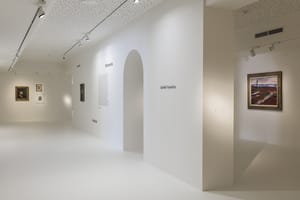 Molds, Hills and Highlands: The Loners of Vysocina, 8smička, 2019; Photo: Ondřej Přibyl, 8smička Endowment Fund
Molds, Hills and Highlands: The Loners of Vysocina, 8smička, 2019; Photo: Ondřej Přibyl, 8smička Endowment Fund Molds, Hills and Highlands: The Loners of Vysocina, 8smička, 2019; Photo: Ondřej Přibyl, 8smička Endowment Fund
Molds, Hills and Highlands: The Loners of Vysocina, 8smička, 2019; Photo: Ondřej Přibyl, 8smička Endowment Fund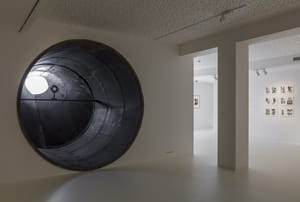 Molds, Hills and Highlands: The Loners of Vysocina, 8smička, 2019; Photo: Ondřej Přibyl, 8smička Endowment Fund
Molds, Hills and Highlands: The Loners of Vysocina, 8smička, 2019; Photo: Ondřej Přibyl, 8smička Endowment Fund Time Out of Mind Mind Out of Time: Glass, 8smička, 2020; Photo: Anna Pleslová, 8smička Endowment Fund
Time Out of Mind Mind Out of Time: Glass, 8smička, 2020; Photo: Anna Pleslová, 8smička Endowment Fund
- Note
Martina Hončíková (výkonná ředitelka od 2020)
Marcela Straková (výkonná ředitelka 2018–2020)
otevírací doba:
St–Ne 10–18
